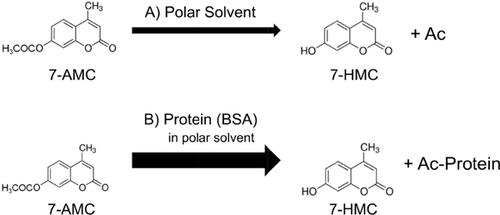Protein & Peptide Letters ( IF 1.0 ) Pub Date : 2020-07-31 , DOI: 10.2174/0929866527666200305143016 Anant Narayan Bhatt 1 , Yogesh Rai 1 , Amit Verma 1 , Sanjay Pandey 1 , Kumar Kaushik 2 , Virinder S Parmar 2 , Anu Arya 3 , Ashok K Prasad 4 , Bilikere S Dwarakanath 1

|
Background: The semi-synthetic acetoxycoumarins are known to acetylate proteins using novel enzymatic Calreticulin Transacetylase (CRTAase) system in cells. However, the nonenzymatic protein acetylation by polyphenolic acetates is not known.
Objective: To investigate the ability of 7-acetoxy-4-methyl coumarin (7-AMC) to acetylate proteins non-enzymatically in the test tube.
Methods: We incubated 7-AMC with BSA and analyzed the protein acetylation using Western blot technique. Further, BSA induced biophysical changes in the spectroscopic properties of 7-AMC was analyzed using Fluorescence spectroscopy.
Results: Using pan anti-acetyl lysine antibody, herein we demonstrate that 7-AMC acetylates Bovine Serum Albumin (BSA) in time and concentration dependent manner in the absence of any enzyme. 7-AMC is a relatively less fluorescent molecule compared to the parental compound, 7- hydroxy-4-methylcoumarin (7-HMC), however the fluorescence of 7-AMC increased by two fold on incubation with BSA, depending on the time of incubation and concentration of BSA. Analysis of the reaction mixture of 7-AMC and BSA after filtration revealed that the increased fluorescence is associated with the compound of lower molecular weight in the filtrate and not residual BSA, suggesting that the less fluorescent 7-AMC undergoes self-hydrolysis in the presence of protein to give highly fluorescent parental molecule 7-HMC and acetate ion in polar solvent (phosphate buffered saline, PBS). The protein augmented conversion of 7-AMC to 7-HMC was found to be linearly related to the protein concentration.
Conclusion: Thus protein acetylation induced by 7-AMC could also be non-enzymatic in nature and this molecule can be exploited for quantification of proteins.
中文翻译:

7-乙酰氧基-4-甲基香豆素的非酶蛋白乙酰化作用:对蛋白质生物化学的影响。
背景:已知半合成乙酰氧基香豆素是使用新型酶钙网蛋白转乙酰酶(CRTAase)系统将蛋白质乙酰化的。然而,通过多酚乙酸酯的非酶蛋白乙酰化是未知的。
目的:研究7-乙酰氧基-4-甲基香豆素(7-AMC)在试管中非酶促乙酰化蛋白质的能力。
方法:我们将7-AMC与BSA一起孵育,并使用Western blot技术分析蛋白质的乙酰化程度。此外,使用荧光光谱法分析了BSA诱导的7-AMC的光谱性质的生物物理变化。
结果:使用泛抗乙酰赖氨酸抗体,在这里我们证明7-AMC在不存在任何酶的情况下以时间和浓度依赖性方式乙酰化牛血清白蛋白(BSA)。与亲本化合物7-羟基-4-甲基香豆素(7-HMC)相比,7-AMC的荧光分子相对较少,但是7-AMC的荧光在与BSA一起孵育时增加了两倍,具体取决于孵育时间和BSA的浓度。过滤后对7-AMC和BSA的反应混合物进行分析表明,荧光增强与滤液中分子量较低的化合物有关,而不与残留的BSA有关,提示荧光较少的7-AMC在蛋白质存在下会发生自水解,从而在极性溶剂(磷酸盐缓冲液,PBS)中产生高度荧光的亲本分子7-HMC和乙酸根离子。发现从7-AMC到7-HMC的蛋白质增强转化与蛋白质浓度线性相关。
结论:因此,由7-AMC诱导的蛋白质乙酰化在本质上也可能是非酶促的,该分子可用于定量蛋白质。









































 京公网安备 11010802027423号
京公网安备 11010802027423号